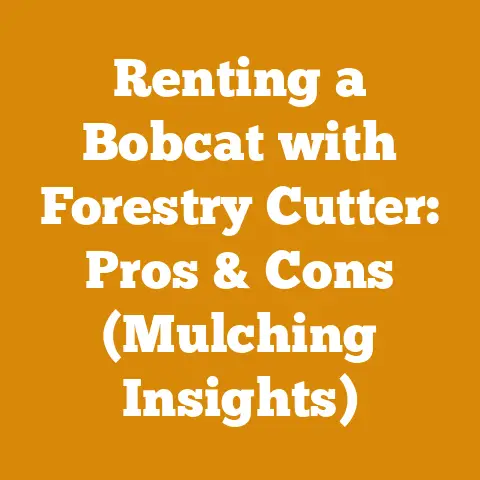BL110 Trimmer Troubleshooting (Engine Burn Smell Explained)
Let’s bust a myth right off the bat: that burning smell coming from your BL110 trimmer is always a sign of catastrophic engine failure. I need a little TLC.” And that’s precisely what we’re going to do. I’ve spent years wrestling with everything from stubborn oaks to nimble willows, and I’ve learned a thing or two about diagnosing the woes of small engines – especially when that dreaded burning smell rears its head.
BL110 Trimmer Troubleshooting: Deciphering the Engine Burn Smell
That acrid scent, that telltale sign of something amiss under the hood of your BL110 trimmer, can be alarming. But before you resign yourself to a costly repair or replacement, let’s break down the potential causes, step-by-step. We’ll cover everything from common culprits to preventative measures, ensuring you can keep your trimmer running smoothly for years to come.
Why Does My Trimmer Smell Like It’s Burning? The Usual Suspects
Think of that burning smell as your trimmer’s way of communicating. It’s not just a random occurrence; it’s a symptom. Here’s a breakdown of the most common causes:
- Overheating Engine: This is the big one. An overheated engine is often the primary suspect when you detect a burning smell.
- Improper Fuel Mixture: Too little oil in your fuel mix can lead to increased friction and heat, resulting in that distinctive burning odor.
- Clogged Air Filter: A dirty air filter restricts airflow, causing the engine to work harder and run hotter.
- Dirty Spark Arrestor: A spark arrestor clogged with carbon deposits can also restrict exhaust flow, contributing to overheating.
- Worn or Damaged Piston Rings: These rings are crucial for sealing the combustion chamber. When they wear down, they allow oil to leak into the combustion chamber, causing it to burn and produce a distinct smell.
- Plastic Melting: Check for plastic components near the engine or exhaust that may be melting from excessive heat.
- Old Fuel: Fuel that has been sitting for too long can degrade and gum up the carburetor, leading to inefficient combustion and overheating.
Deep Dive: The Science Behind the Smell
The burning smell isn’t just a random odor; it’s a complex chemical reaction. When an engine overheats, various components begin to break down and release volatile organic compounds (VOCs). These VOCs, often containing hydrocarbons and other byproducts of combustion, are what we perceive as that “burning” smell.
Consider this: Engine oil, when subjected to extreme temperatures, can undergo thermal cracking, breaking down into smaller, more volatile molecules. These molecules then burn incompletely, producing a pungent odor. Similarly, plastic components, especially those made from polymers with low heat resistance, can melt and release characteristic smells as they decompose.
Personal Experience: The Case of the Overworked Weed Wacker
I remember one sweltering summer. I was clearing a particularly overgrown patch of blackberry bushes, pushing my trusty (but somewhat neglected) trimmer to its absolute limit. Suddenly, the dreaded burning smell filled the air. I immediately shut it down, fearing the worst. After letting it cool, I discovered the air filter was completely clogged with dust and debris. The engine had been working overtime, struggling to breathe, and overheating in the process. A quick filter cleaning and a little bit of preventative maintenance later, it was back to its old self. This taught me a valuable lesson about the importance of regular maintenance, especially during heavy use.
Troubleshooting Your BL110: A Step-by-Step Guide
Alright, let’s get down to brass tacks. Here’s a systematic approach to diagnosing and addressing that burning smell:
-
Safety First! Before you start tinkering, disconnect the spark plug wire to prevent accidental starting. Allow the engine to cool completely.
-
Visual Inspection:
- Check for Leaks: Look for any signs of oil or fuel leaks around the engine, fuel lines, and carburetor.
- Inspect the Spark Plug: A fouled or damaged spark plug can indicate improper combustion.
- Examine Plastic Components: Carefully inspect any plastic parts near the engine or exhaust for signs of melting or discoloration.
-
Air Filter Inspection:
- Remove the Air Filter: Locate the air filter housing and remove the filter.
- Assess the Condition: Is it visibly dirty, clogged with debris, or damaged?
- Cleaning or Replacement: If the filter is simply dirty, try cleaning it with compressed air. If it’s heavily soiled or damaged, replace it. I recommend replacing air filters at least once a season, or more frequently if you use your trimmer in dusty conditions.
-
Fuel System Check:
- Fuel Mixture: Ensure you’re using the correct fuel-to-oil ratio recommended by the manufacturer (usually 50:1). Using too little oil can cause excessive friction and overheating.
- Fuel Quality: Is the fuel fresh? Old fuel can degrade and cause problems. If the fuel has been sitting for more than a month or two, drain it and replace it with fresh fuel.
- Fuel Filter: Check the fuel filter (usually located inside the fuel tank) for clogs. A clogged fuel filter can restrict fuel flow and cause the engine to run lean, leading to overheating.
-
Spark Arrestor Inspection:
- Locate the Spark Arrestor: The spark arrestor is typically located on the muffler.
- Remove and Inspect: Carefully remove the spark arrestor and inspect it for carbon buildup.
- Cleaning: Use a wire brush to remove any carbon deposits. If the spark arrestor is heavily clogged, you may need to soak it in a carburetor cleaner.
-
Engine Overheating:
- Check Cooling Fins: Make sure the cooling fins on the engine are clean and free of debris. These fins help dissipate heat.
- Operating Conditions: Are you using the trimmer for extended periods in hot weather? Give it breaks to cool down.
- Load: Are you trying to cut through material that’s too thick or dense for the trimmer to handle?
-
Piston Ring Check (Advanced):
- Compression Test: A compression test can help determine if the piston rings are worn or damaged. This requires specialized tools and knowledge. If you’re not comfortable performing a compression test yourself, take the trimmer to a qualified repair shop.
Data Point: The Impact of Fuel Quality
Studies have shown that using ethanol-blended fuel (E10) in small engines can lead to a variety of problems, including fuel degradation, water absorption, and corrosion of fuel system components. A study by the Outdoor Power Equipment Institute (OPEI) found that over 70% of small engine repairs are related to fuel issues. Using ethanol-free fuel or adding a fuel stabilizer can help mitigate these problems.
The Importance of Regular Maintenance: A Preventative Approach
The best way to avoid that dreaded burning smell is to practice regular maintenance. Think of it like this: a little preventative care can save you from a major headache down the road. Here’s a maintenance checklist:
- Air Filter: Clean or replace the air filter every 25 hours of use, or more frequently in dusty conditions.
- Fuel System: Use fresh fuel and a fuel stabilizer. Drain the fuel tank before storing the trimmer for extended periods.
- Spark Plug: Replace the spark plug annually.
- Spark Arrestor: Clean the spark arrestor every 50 hours of use.
- Lubrication: Check and lubricate moving parts according to the manufacturer’s recommendations.
- Engine Cooling: Keep the engine cooling fins clean.
Wood Species and Their Impact on Trimmer Performance
While the type of wood you’re trimming doesn’t directly cause a burning smell, it can indirectly contribute to engine strain and overheating. For instance, cutting through dense, woody weeds or thick brush requires more power and can put a greater load on the engine. This is especially true for species like:
- Osage Orange (Hedge Apple): Exceptionally dense and hard, this wood can really tax your trimmer.
- Hickory: Known for its toughness and density, hickory requires more power to cut through.
- Black Locust: Another incredibly durable and dense wood that can strain your trimmer.
When dealing with these tougher species, it’s important to use the correct cutting head and to avoid forcing the trimmer. Let the tool do the work, and give the engine breaks to cool down.
Tool Selection: Choosing the Right Cutting Head
The type of cutting head you use on your BL110 can also affect engine performance. Here’s a quick rundown:
- String Trimmer Head: Ideal for light-duty trimming of grass and weeds.
- Brush Cutter Blade: Designed for heavier-duty cutting of thick brush and small saplings.
- Metal Blades: Offer increased cutting power and durability for tackling tougher vegetation.
Using the wrong cutting head can overload the engine and contribute to overheating. Always choose the appropriate cutting head for the task at hand.
Case Study: The Firewood Producer’s Dilemma
I once consulted with a small-scale firewood producer who was experiencing frequent trimmer failures and, you guessed it, that persistent burning smell. He was using his trimmers to clear brush and small trees around his woodlot. After a thorough assessment, I discovered several contributing factors:
- Neglected Maintenance: His trimmers were rarely cleaned or serviced.
- Improper Fuel Mixture: He was using an incorrect fuel-to-oil ratio.
- Overloading the Engine: He was trying to cut through trees that were too large for his trimmers.
By implementing a regular maintenance schedule, using the correct fuel mixture, and switching to a more powerful brush cutter for larger trees, he significantly reduced his trimmer failures and eliminated the burning smell. This case study highlights the importance of addressing multiple factors to solve engine problems.
Actionable Takeaways: Improving Your Trimmer’s Longevity
Here are some actionable steps you can take to improve your BL110 trimmer’s longevity and prevent that dreaded burning smell:
- Create a Maintenance Schedule: Develop a regular maintenance schedule and stick to it.
- Use Fresh Fuel and a Fuel Stabilizer: Always use fresh fuel and add a fuel stabilizer to prevent fuel degradation.
- Choose the Right Cutting Head: Select the appropriate cutting head for the task at hand.
- Avoid Overloading the Engine: Don’t try to cut through material that’s too thick or dense for the trimmer to handle.
- Give the Engine Breaks: Allow the engine to cool down periodically, especially during heavy use.
- Store the Trimmer Properly: Before storing the trimmer for extended periods, drain the fuel tank and clean the air filter.
Cost-Effectiveness: Investing in Preventative Maintenance
While it might seem like a hassle to perform regular maintenance, it’s actually a very cost-effective strategy in the long run. A few dollars spent on air filters, fuel stabilizers, and spark plugs can save you hundreds of dollars in repair costs or replacement costs down the road. Think of it as an investment in your trimmer’s longevity.
Safety Standards: Protecting Yourself and Your Equipment
When working with power equipment, safety should always be your top priority. Here are some safety tips to keep in mind:
- Wear Appropriate Safety Gear: Always wear safety glasses, hearing protection, and gloves when operating your trimmer.
- Read the Owner’s Manual: Familiarize yourself with the manufacturer’s instructions and safety guidelines.
- Work in a Well-Ventilated Area: Avoid operating the trimmer in enclosed spaces.
- Keep Bystanders Away: Maintain a safe distance from bystanders when operating the trimmer.
- Inspect the Trimmer Before Each Use: Check for any loose parts, leaks, or damage before starting the engine.
Global Considerations: Adapting to Local Conditions
Wood processing and firewood preparation practices vary significantly around the world, depending on factors such as climate, wood availability, and local regulations. For example, in some regions, firewood is the primary source of heating, while in others, it’s used primarily for recreational purposes. Similarly, the types of wood available vary greatly from region to region.
When troubleshooting your BL110 trimmer, it’s important to consider these local conditions. For instance, if you live in a hot, humid climate, you may need to clean your air filter more frequently. Or, if you’re using the trimmer to clear brush in a heavily wooded area, you may need to use a brush cutter blade instead of a string trimmer head.
The Psychology of Wood Processing: Finding Satisfaction in the Task
Beyond the technical aspects of wood processing and firewood preparation, there’s also a psychological dimension. Many people find a sense of satisfaction and accomplishment in working with wood, whether it’s felling a tree, splitting logs, or simply maintaining their property with a trimmer. This connection to nature and the satisfaction of creating something tangible can be a powerful motivator.
Final Thoughts: Mastering the Art of Trimmer Maintenance
Dealing with a burning smell in your BL110 trimmer can be frustrating, but with a systematic approach and a little bit of knowledge, you can diagnose the problem and get your trimmer back in action. Remember to prioritize safety, practice regular maintenance, and adapt your techniques to your local conditions. By mastering the art of trimmer maintenance, you can extend the life of your equipment and enjoy the satisfaction of a job well done. And remember, that burning smell is a signal – listen to what your trimmer is trying to tell you!






